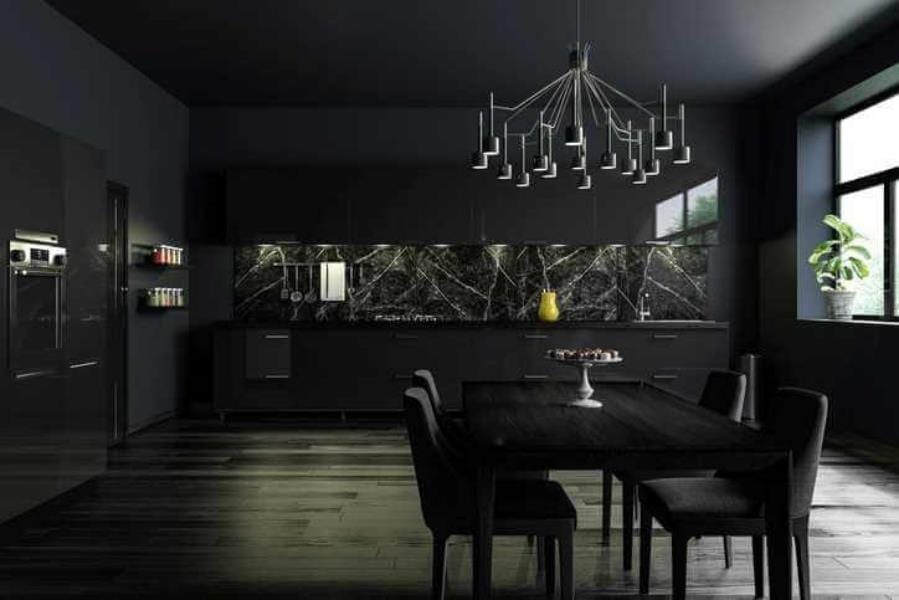How to Paint Over Bold Colors Using Fewer Coats
Painting is one of the quickest and easiest ways to update your dwelling house. However, depending on the color yous're trying to cover, painting might not be quick or easy. Keeping upwardly with the latest color trends can lead to pastels, jewel tones and everything in between – and of course, you need to choice the right paint sheen: flat, eggshell, satin, gloss. Just when you're gear up to make a change, some colors are notoriously difficult to conceal under fresh pigment. How can you paint over bold colors to make certain that new colors have in a few coats and don't bleed through?
Prep work

Ben Akiba/Getty Images
It's less a affair of what colors are hardest to pigment over only more than about the transition, according to Jimmy Slattery, senior product director at Valspar. "The more desperate the transition (lite to night, dark to calorie-free) the more difficult it can exist to get the job done in less coats."If your paint job entails a desperate transition, Slattery recommends that you apply a loftier hiding primer. If yous tin, get the primer in a tone close to the new color. "Also, vibrant reds, yellows and oranges tin struggle to hide no matter what color they're going over," he explains. Slattery recommends applying a low-cal or medium gray tinted primer as this volition reduce the number of coats that you'll demand.

Peter Zvonar/Getty Images
The importance of primers
Brian Osterried, PPG Paints product marketing manager, agrees that priming is the fundamental to success. This is true when you're trying to comprehend night colors with low-cal colors – and he says when trying to cover calorie-free colors with nighttime colors. "When going from black to a lite or medium colour, a grey or deep base primer is recommended, such every bit PPG Paints SEALGRIP® tinted to grey," he says. "Darker primers let the lighter hue to cover in less coats and reduce the adventure that the night color will drain through."

Gladiathor / Getty Images
Tina Nokes, co-owner of Five Star Painting in Loudoun County, VA, adds that "Many people try to skip the primer stride thinking that ii topcoats will do the job." However, she says you can prime now or prime afterward. "A primer will ensure that you don't have to become dorsum and prime afterwards ii top coats, or you may end up applying a third and fourth coat of pigment for adequate coverage when the finished result is not what you hoped."Nokes recommends using a loftier-quality stain-blocking primer. "This volition go along dark paint colors from seeping through the fresh topcoat," she explains. "Applying paint primer will also let for no more than two coats of coverage, raise the paint'due south adhesion, and minimize the chance of the cease appearing streaky and uneven." However, even with a primer, Nokes says that i coat of paint is rarely enough – especially to comprehend the virtually fashionable color of the year. "Two coats are about e'er required after using primer to assure even coverage and no flashing of the one-time color."She agrees that the primer should be tinted a grey color – or similar to the topcoat that you plan to use.
Quality products matter

Wachirawut Priamphimai/EyeEm/Getty Images
While it's of import to utilize a high-quality primer, this doesn't mean that you can skimp on the other materials. "Aside from the surface you're painting and the previous blanket underneath it, the biggest factor when it comes to repainting over a colored surface is the product yous cull to use when repainting, " says Osterried.That might audio like just a sales pitch, but Nokes agrees. She says that a college quality paint does a better job of roofing dark walls considering it contains greater levels of binders and pigments. "And these binders and pigments are necessary for hiding difficult colors and boosting coverage." If yous use lower price paints, Nokes warns that they may not provide the coverage yous demand. This could result in your walls needing more two coats after the primer has been applied.Using top-tier tools is also important. "Apply high-quality rollers and pigment bushes to make your painting project easier and more efficient," Nokes says. "These tools deliver the paint in a smoother, thicker coat, which works to muffle the dark color."
Final Tips

Paint Over Image: Paolo De Santis/EyeEm/Getty Images
Before yous apply the primer, be sure to prep your walls. "Fill in blast holes and sand through rough spots to brand sure the surface is smooth and free of structural problems," Nokes advises. "To ensure a perfect surface, wash the walls with a solution comprised of mild dish detergent and warm water to remove clay." She also recommends using a drywall pole sander. "This will break downward the paint color, and increment adhesion," Nokes explains.In addition, she recommends that yous cut and scroll while keeping a moisture edge. "This keeps the new colour coverage consistent and assures that the cutting lines won't show up on thwall."
scratchleytoorepithe.blogspot.com
Source: https://www.mymove.com/painting/guides/paint-bold-colors/